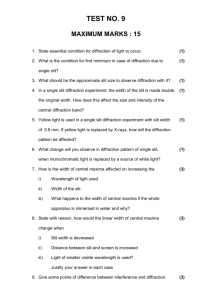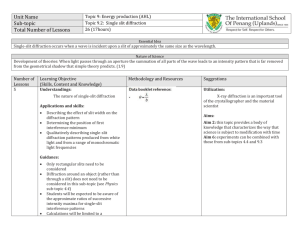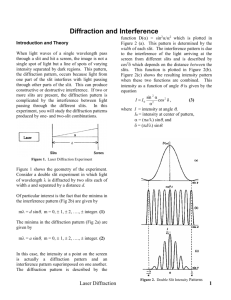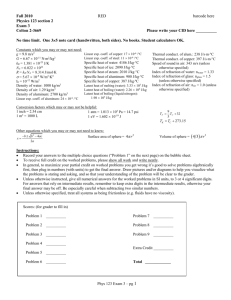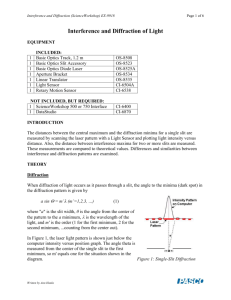warren-diffraction and interference - Helios
advertisement
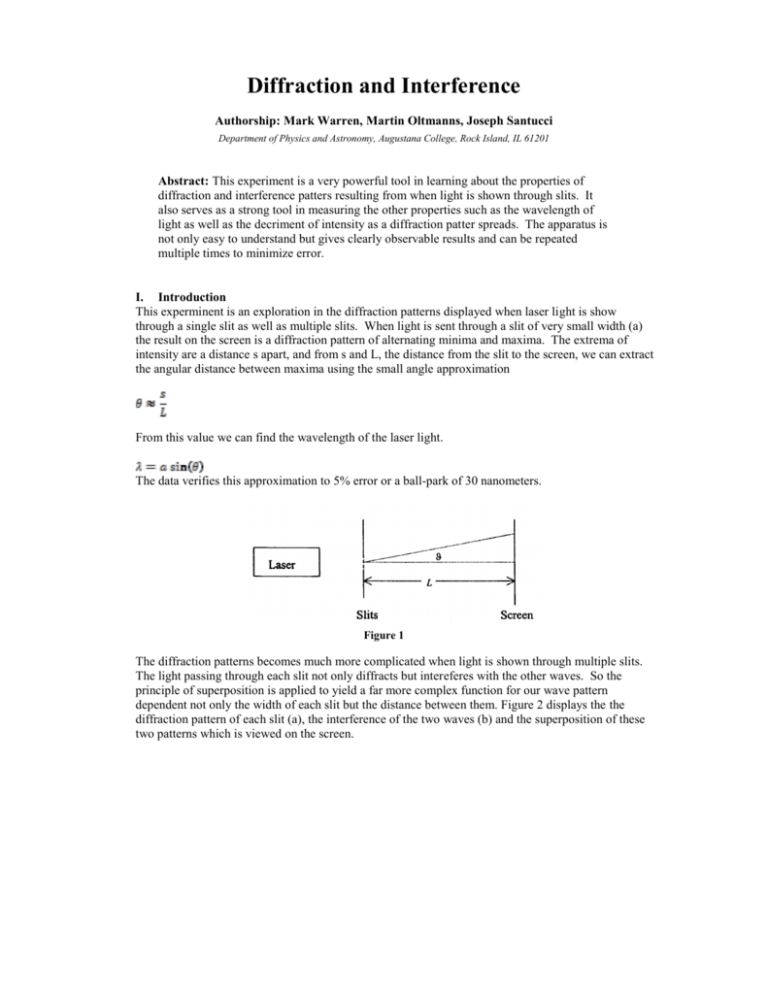
Diffraction and Interference Authorship: Mark Warren, Martin Oltmanns, Joseph Santucci Department of Physics and Astronomy, Augustana College, Rock Island, IL 61201 Abstract: This experiment is a very powerful tool in learning about the properties of diffraction and interference patters resulting from when light is shown through slits. It also serves as a strong tool in measuring the other properties such as the wavelength of light as well as the decriment of intensity as a diffraction patter spreads. The apparatus is not only easy to understand but gives clearly observable results and can be repeated multiple times to minimize error. I. Introduction This experminent is an exploration in the diffraction patterns displayed when laser light is show through a single slit as well as multiple slits. When light is sent through a slit of very small width (a) the result on the screen is a diffraction pattern of alternating minima and maxima. The extrema of intensity are a distance s apart, and from s and L, the distance from the slit to the screen, we can extract the angular distance between maxima using the small angle approximation From this value we can find the wavelength of the laser light. The data verifies this approximation to 5% error or a ball-park of 30 nanometers. Figure 1 The diffraction patterns becomes much more complicated when light is shown through multiple slits. The light passing through each slit not only diffracts but intereferes with the other waves. So the principle of superposition is applied to yield a far more complex function for our wave pattern dependent not only the width of each slit but the distance between them. Figure 2 displays the the diffraction pattern of each slit (a), the interference of the two waves (b) and the superposition of these two patterns which is viewed on the screen. Figure 2 The compacted equation of light is as follows is As more slits are added, the wave function becomes more and more complex. Figure 3 illustrates this with the addition of secondary maxima. It is important to notice, however, that the primary maxima do not change location. This fact was observed and confirmed experimentally Figure 3 II. Experimental Setup The measurement of the diffraction intensity was carried out as follows. A green laser (532 nm) was shown through a single slit towards a high sensitivity light sensor. The sensor was first mounted onto a rotary motion sensory approximately at the center of the diffraction pattern. The motion sensor was attached to a mechanical Linear Translator to create a correspondence between lateral position of the light sensor and the angular position of the sensor. The intensity of light could then be read and mapped to a relative position in the diffraction pattern. Data was recorded electronically for the full range of position on the rotary motion sensor. Figure 4 This process was then repeated while using two, three, and four, slits and data on their corresponding positions and intensity was recorded in the same fashion. III. Analysis and Results The wavelength of green light was found experimentally to be 532 nm which is within 6% error of the actual value of the light source. Although is most practices 6% is an unacceptable amount of error, it must be stated that given the delicacy of the experimental apparatus, 6% suffices. The rotary motion sensor was first operated by hand and therefore played an arguable source of error if at any point the apparatus was “bumped.” The light sensor could have either recorded too high or too low depending on how the apparatus was disrupted. 6% is percent is also a reasonably error given the extremely small discrepancy in length. Since the intensity of light was measured by the sensor in arbitrary. The values of intensity have been calibrated to a percentage relative to the center maximum. The following two plots display the same sets of data for 2, 3 and 4 slit diffraction. However, Figure 5 displays a curved fit of each data, and the figure 6 superimposes the ideal function of primary maxima onto the data sets. As is, the data points alone are very close especially between the 2 slit and 3 slit data. The 4-slit data point still match in the location of maxima, however the light intensity is much too high. This could possibly be explained extra light reaching the sensor from inside the room. Therefore each maxima would be at a value comparatively, so it is conievable the stray light from either a lamp or another group’s experiment played a part in the error. Figure 5 I=(sin(236.209974*x))^2/((236.209974*x)^2)*(cos(738.1561686*x))^2 2 Slit 3 Slit 4 Slit 1.0 Intensity (% max) 0.8 0.6 0.4 0.2 0.0 -0.02 -0.01 0.00 0.01 0.02 Theta Figure 6 IV Conclusion. As desired, the experiment proved to be a good exploration into the physics of light diffraction and interference. Having both confirmed the dependency of a diffraction on the wavelength of light as well as the width of and between slits. These parameters then successfully described the interference of multi-slit patterns while maintaining the angular position and intensity of primary maxima *proofread, please *propagate experimental error *2-slit eqn distinct from D(alpha), and give some details about how you got that *88



